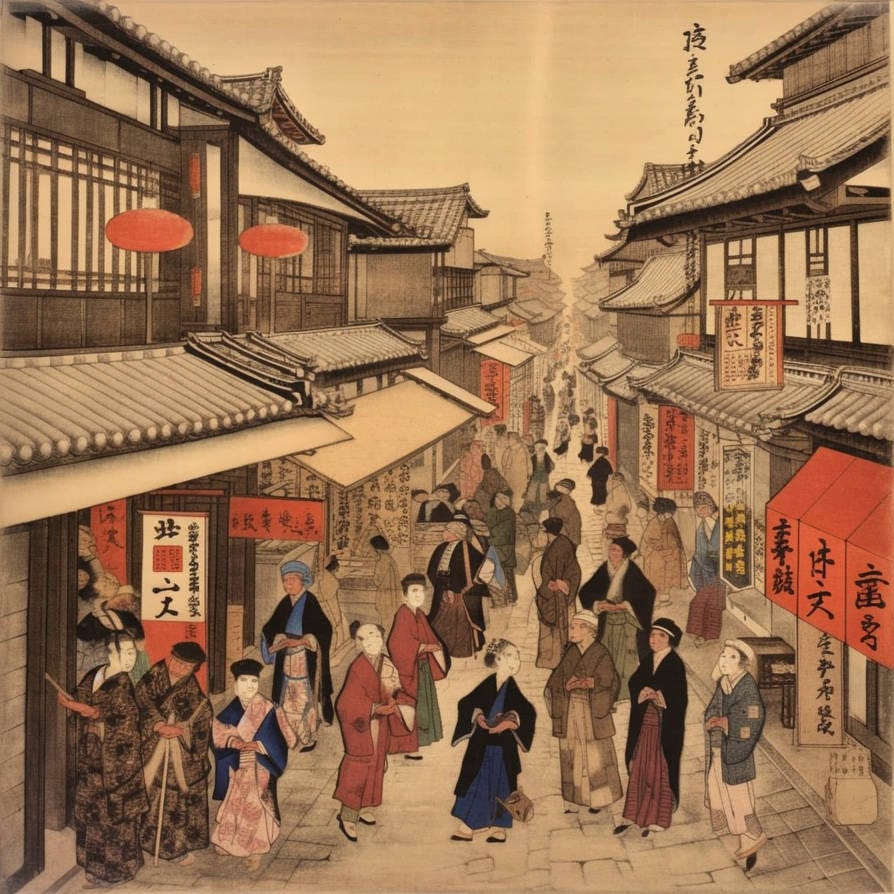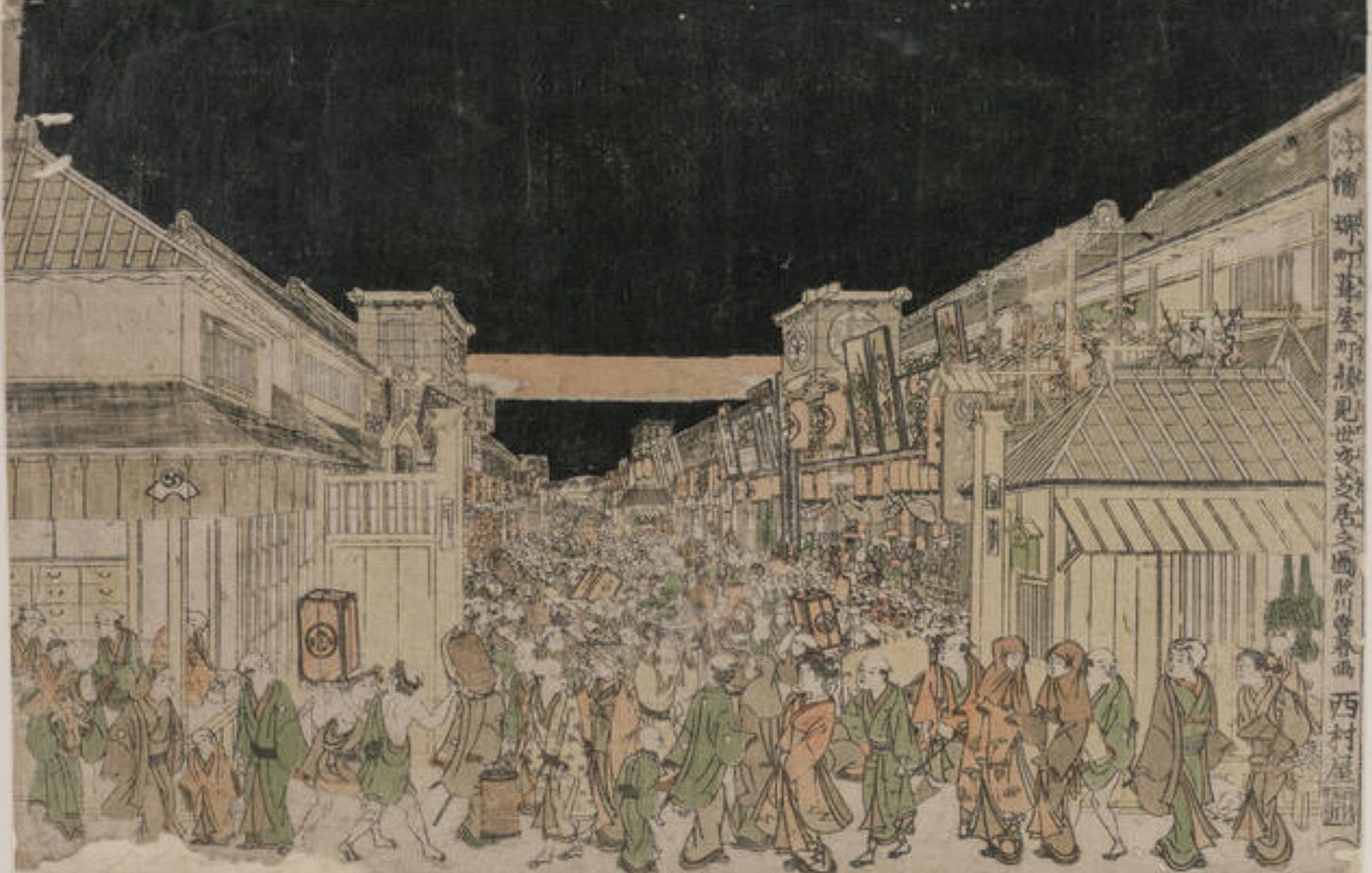Samurai would always walk on the left side of the street.
The German physician and naturalist Engelbert Kaempfer visited Japan for two years from September 1690, during which he twice visited Edo and met the fifth Shogun Tokugawa Tsunayoshi. He noted in his diary on his way from Nagasaki to Kyoto that, ``On the left side of the main street are people heading to Kyoto, and on the right side are people coming from Kyoto.'' The custom of keeping to the left of the street was an unwritten rule, that had taken root in Japan as early as the mid-Edo period.
Samurai walked on the far left as a means of protecting themselves, especially to protect their blind spots. Basically, if your sword is mounted to your left, to attack to the right, you can attack as soon as you unsheathe your sword, but to attack to the left, you will be at a slight disadvantage as you’ll need to draw your sword and then turn into attack position. Therefore, the left side is where samurai ideally should protect. By keeping buildings to the left, one can lessen the chance of fatal attack.
Another main reason was so that commoners would not come into contact with, nor would samurai bump anyone or anything with the scabbards of their swords. To do so was considered the height of bad manners, and knocking another warriors’ scabbard with your own, an incident known as as saya-ate, was deemed enough of an insult to require the drawing of swords! As swords were worn on the left hip, to avoid any unpleasant situations, the samurai — and therefore the general population — would keep to the left hand side when walking the streets or paths. This is said to have been a major reason for Japan to have followed British road laws, and to drive on the left hand side of the road.
Driving on the left was the early world standard!
Currently, most countries around the world drive on the right-hand side. However, archeological excavations and researching the remains of ancient ruts shows that ancient people often walked or drove their carts on the left. In a time of warfare, it’s common sense for sword armed warriors to drive on the left side to be able to use their weapons against an enemy, as right-handed soldiers had an advantage in attacking on the right side. Since the beginning of time, most humans have been right-handed, and we have created a society that accommodates this.
The French leader Napoleon’s tactics have been credited with causing the world to drive on the right. Napoleon focused on attacking from the right, confusing the enemy by having both soldiers and horses move to the right. This apparently influenced the countries Napoleon occupied, hence continental Europe drives on the right.
Tokyo Left, Osaka Right
When riding an escalator, the current custom in eastern Japan — anywhere east of Sekigahara — is to stand on the left and leave the right side open to give way to people who are in a hurry. When riding an escalator anywhere west of Sekigahara, people stand to the right of escalators, leaving the left side open. In the Edo period, over 260 feudal clans across the country maintained residences in Edo under the sankin kotai alternate attendance system. Therefore, it is said that half of the population of Edo was samurai class. In comparison, Osaka’s samurai population was small, and society was centered around the merchants. The theory is that eastern Japan’s penchant for standing to the left is a remnant of the samurai custom of wanting to protect their left side.
That Sekigahara is the centerpoint for standing left or right on an escalator also harks back to the samurai era, as in 1600, Japan had broken into two factions, East (Tokugawa) and West (Toyotomi loyalists) at the time of the Battle of Sekigahara. Incidentally, there is only one escalator in Sekigahara. This is found in the Sekigahara Museum, opened in 2020.
Left First
On the topic of left, when donning their armor, samurai would always put on the left side pieces, such as the left suneate shin guards and the left kote, armored sleeves first. The reason for this is because most samurai weapons are used with the left leg and left hand facing the enemy. The bow is held foreword in the left hand while the rear facing right hand notches the arrow and draws the bow string. Early bowmen sometimes used only the left armored sleeve, allowing freedom of movement with their right arm. The spear is held left hand forward, likewise the later matchlock gun too is used left hand forward. For that reason, it was considered auspicious and prudent to fit the pieces of armor facing the enemy — the left — first.
Signs
Of interest, the signs of the many shops, inns and establishments along the major highways such as the Tokaido and the Nakasendo had their name in Kanji characters on one side, and simpler, native Hiragana on the other side. These business signs were displayed in such a way that travelers going to Edo would see the signs written in Kanji, while Kyoto bound travelers would see the signs in Hiragana.
The reason for this was that many a weary traveler would awaken in the morning, and forgetting which side of the road their lodgings or inn was located, would accidentally set off in the wrong direction. By looking at the signs, one could tell if they were heading towards Edo or Kyoto.
Right Is Right
There are many Japanese historical figures who are said to have been left-handed, such as the Heian period military commander Minamoto no Tametomo, the great swordsman Miyamoto Musashi (although I have a theory, he was not just left-handed but ambidextrous – more on that in a later article) , daimyo Matsunaga Hisahide and the late Edo period Shinsengumi captain Saito Hajime to name a few, but unfortunately there are no accurate historical records of them being left handed. Why weren’t left-handed people recorded in historical records? Because for a samurai, being left-handed was considered a disgrace and a bad habit that had to be hidden. In Old Japan particularly, etiquette and conformity were to be adhered to. Even if one was naturally left-handed one would have been “corrected” from an early age, trained — read forced — to use chopsticks, brushes and weapons with the right hand. That’s right, samurai were corrected for being Left-handed, and so left-handed samurai were not a thing as such. Yet another reason lies in the rules of etiquette when meeting or sitting down and facing another person. In the Edo period, a samurai would carry, or if sitting, place his sword, to his right, where it would be difficult to draw the sword. This was to show there was no hostile intent.
Speculation that Hajime Saito was left-handed has been inferred from his self-portraits. It has been suggested that Hajime Saito and others were able to win by misleading their opponents because they were left-handed, which led to them being perceived as strong. Certainly, Saito is known to have mastered a sword fighting technique known as tsuki, a sudden left hand lunge, stabbing at the throat to take out an opponent, but it is not necessarily a left-hander’s technique and until recently was taught as a Kendo move.
Left-Handed Samurai Guns
Of interest are the very few surviving examples of left-handed matchlock guns, featuring the serpentine, the flashpan and other firing features on the left side of the gun. While this could have been for left-handed gunners, it is my suggestion that it is also possible they were produced to be used, for example, on castle watchtower corners, to extend the right flank range, even if only slightly.
Left-handedness was seen as a disturbing characteristic in samurai society, and so from ancient times people were trained to become right-handed. Even today, up until around the Showa era, (1926-1989) many people who were born left-handed were forced to become right-handed. Indeed, the reasons as mentioned above makes sense in such a military society. And it gives us a fascinating look at the rich history with which we have been…left.






Excellent article mate and very much appreciated 👍🙏🤝
Very interesting, thanks!